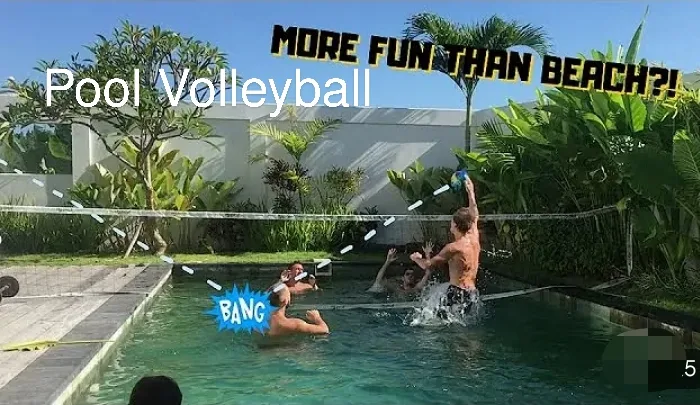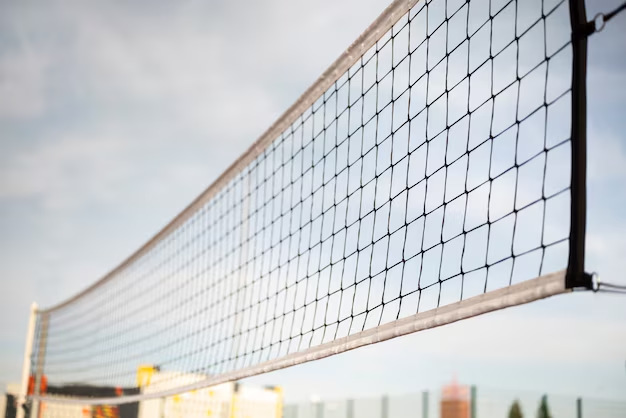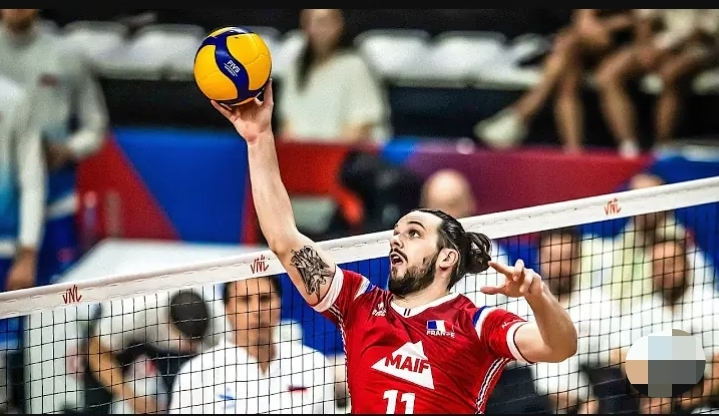Pool volleyball is a variation of traditional volleyball played in a swimming pool.
It combines the excitement and competition of volleyball with the refreshing environment of water.
The game typically involves two teams who aim to score points by hitting a volleyball over a net and into the opposing team’s side of the pool, trying to prevent the other team from returning it.
How Pool Volleyball Works
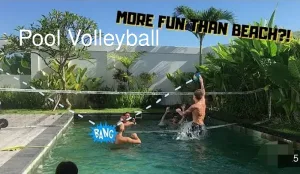
In pool volleyball, the basic rules are similar to regular volleyball, but the water adds an extra layer of challenge and fun. Here’s how it generally works:
- Teams: Players are divided into two teams. The number of players can vary, but typically each team has 2–6 players depending on the size of the pool and the number of participants.
- The Net: A volleyball net is set up across the pool, either floating on the water or fixed to the pool edges. The net’s height can be adjusted to accommodate different skill levels and age groups.
- The Ball: The game uses a volleyball designed for water play. These balls are usually lighter and more buoyant than standard volleyballs, making them easier to handle in the water.
- Gameplay: The game starts with a serve, where one team hits the ball over the net to the other team. The receiving team then attempts to return the ball over the net within three hits. The game continues until one team fails to return the ball, resulting in a point for the other team.
- Scoring: Pool volleyball is often played to a set number of points, typically 21, with the winning team needing to win by at least 2 points. However, the rules can be adjusted for shorter or longer games.
Why play pool volleyball?
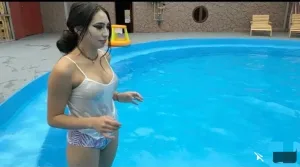
Pool volleyball is a popular activity for several reasons:
- Fun and Social: It’s a great way to bring people together for a fun and interactive experience. The game encourages teamwork and friendly competition, making it perfect for gatherings, parties, or just a casual day in the pool.
- Refreshing Exercise: Playing volleyball in water adds resistance to your movements, providing a good workout without the impact on joints that comes with land-based sports. This makes it an excellent low-impact exercise suitable for people of all ages.
- Versatility: Whether you’re in a small backyard pool, at a large public pool, or even at the beach, pool volleyball can be adapted to different environments, offering flexibility in how and where you play.
Essential equipment for pool volleyball
To get started with pool volleyball, you’ll need some basic equipment. The most important piece is a pool volleyball net. These nets are specially designed to withstand water exposure and the rough-and-tumble nature of pool games. Look for a net that is adjustable in height to accommodate different players and is made of durable, water-resistant materials.
You’ll also need a inflatable volleyball – volleyball that’s suitable for pool use. These balls are typically lighter and more buoyant than standard volleyballs, making them easier to handle in the water. Additionally, consider investing in some poolside accessories like floats or seating for players who want to take a break between matches.
How to Set Up a Pool Volleyball Game: Pool Volleyball Set
Setting up a pool volleyball game is easy and can be done in just a few steps. First, choose the right spot in the pool where the water depth is consistent and safe for all players. Position the net across the pool, ensuring it’s taut and stable. Most nets come with adjustable straps or weights to keep them in place.
Next, adjust the net height. For younger players or those less experienced, a lower net height may be preferable. For more competitive games, raise the net to add an extra challenge. Don’t forget to set some ground rules for safety—like no diving or rough play—to ensure everyone has a great time. Consider the following tips when setting up your pool volleyball
Setting Up a Net in Your Pool
One of the most popular ways to play pool volleyball is by installing a volleyball net directly in your pool. This setup is perfect for creating an engaging and energetic environment where everyone can join in the fun. Pool volleyball nets come in various styles, including floating nets that drift on the water and fixed nets that attach to the pool’s edges.
When choosing a net, consider the size and age of the players. For families with young children, a small inflatable volleyball net is a great choice. It’s easy to set up and adjust, and it helps kids get comfortable with being in the water while they burn off some energy. As they grow more confident, you can upgrade to a larger, more permanent net that offers a more challenging game.
By adding a volleyball net to your pool, you effectively turn your backyard into a mini sports arena. Pool games like this are not just fun; they also encourage physical activity and help improve coordination and teamwork.
Floating pool volleyball courts
If you’re looking for a more versatile way to enjoy pool volleyball, consider a floating pool volleyball court. These inflatable volleyball courts are designed to float on the water, creating a full volleyball court wherever you want it—whether in a swimming pool, at the beach, or on the calm waters of a lake.
A floating volleyball court typically consists of a net and inflatable tubes that outline the court’s boundaries. This setup is ideal for larger bodies of water, making it a popular choice for campsites, holiday clubs, schools, families, and beach resorts. The floating court offers a refreshing twist on traditional volleyball, as players can enjoy the game with the added challenge of playing while partially submerged in water.
The water not only keeps players cool but also cushions falls, making the game safer and more comfortable. Plus, the unique experience of playing on a floating court adds an extra layer of excitement, making it a favorite for group events and summer gatherings.
Pool volleyball game rules
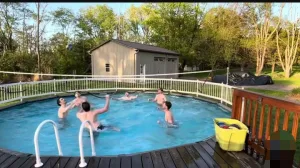
The rules of pool volleyball are similar to traditional volleyball but adapted for water play. Teams of two or more players try to hit the ball over the net and into the opposing team’s side of the pool. The aim is to prevent the other team from returning the ball, scoring a point when they fail to do so.
A typical game is played to 21 points, but you can adjust this depending on the time and the players’ energy levels. For mixed skill levels, consider modifying the rules to keep the game fun and inclusive. For instance, allowing a few extra hits before the ball must go over the net can make the game more enjoyable for beginners.
Types of pool volleyball setups
There are two main ways to set up a game of pool volleyball:
- Fixed or Floating Pool Volleyball Net: This setup involves placing a net across your pool. Some nets are designed to float on the water, while others are fixed to the pool’s edges. This is ideal for those who have a dedicated pool space for regular play.
- Floating pool volleyball court: For a more versatile option, a floating pool volleyball court can be used. This inflatable volleyball court setup includes not just a net but also boundary markers that float on the water’s surface, creating a full volleyball court. It’s perfect for playing at the beach, in a lake, or even in a larger pool.
Tips for Improving Your Pool Volleyball Skills
Whether you’re a seasoned player or just starting out, improving your pool volleyball skills can make the game even more enjoyable. Here are a few tips:
- Master your serve: A good serve is key to starting the game on the right foot. Practice serving the ball with a firm, steady hand to get it over the net consistently.
- Improve your reaction time: The water slows down your movements, so focus on quick reflexes. Practice moving side-to-side in the pool and reacting to the ball as soon as it comes your way.
- Work on your teamwork: Pool volleyball is all about cooperation. Communicate with your teammates, call out plays, and always be ready to back each other up.
Hosting a pool volleyball party
Hosting a pool volleyball party is a great way to bring people together. Start by setting up the pool area with plenty of seating and shade. Have some snacks and drinks on hand to keep everyone refreshed, and consider playing some upbeat music to keep the energy high.
You can also add some fun variations to the game. Try water balloon volleyball, where players use water balloons instead of a volleyball, or create obstacles in the pool to make the game more challenging. These variations keep the game fresh and entertaining, especially for larger groups.
Maintenance Tips for Pool Volleyball Equipment
To ensure your pool volleyball equipment lasts, it’s important to take good care of it. After each game, rinse the net and volleyball with fresh water to remove chlorine and other chemicals. Allow them to dry completely before storing them away to prevent mildew and deterioration.
If your net comes with metal parts, such as poles or tension cables, check them regularly for signs of rust or corrosion. Storing your equipment in a cool, dry place will help extend its lifespan, so you can enjoy many more games of pool volleyball in the future.
FAQs About Pool Volleyball and Volleyball Pool Play
1. What is pool play in volleyball?
Pool play in volleyball refers to the preliminary round of a tournament where teams are divided into groups or “pools.” Each team within a pool plays against every other team in the same pool. The results from these matches determine the team’s ranking within the pool, which then influences their seeding for the subsequent knockout or playoff rounds. Pool play is designed to give each team multiple opportunities to compete, ensuring a fair assessment of their skills before moving on to the more intense elimination stages.
2. How does Olympic volleyball pool play work?
In the Olympics, volleyball pool play follows a similar structure to other tournaments but with specific rules to accommodate the high level of competition. Teams are divided into pools, typically of four to six teams. Each team plays every other team in their pool. The matches are played in a round-robin format, meaning each team competes against all the other teams in their pool. The top teams from each pool then advance to the knockout stages, where they compete for medals. The rankings in pool play are usually based on the number of wins, but tiebreakers like point differential or head-to-head results may also be used.
3. What does pool play mean in volleyball?
Pool play means the initial phase of a tournament where teams are grouped into pools, and each team plays several matches against other teams in the same pool. This format is beneficial because it gives teams multiple games, allowing them to build momentum, adjust strategies, and recover from early losses. The results from pool play determine which teams advance to the next round, often based on their win-loss records.
4. How high should a pool volleyball net be?
The height of a pool volleyball net can vary depending on who is playing. For standard adult play, the net height is usually set around 7 feet 11 ⅝ inches (2.43 meters) for men and 7 feet 4 ¼ inches (2.24 meters) for women, similar to indoor volleyball standards. However, when playing in a pool, the net height might be adjusted slightly lower for convenience and safety, especially if the water depth or the players’ swimming ability is a concern. For casual or family play, you can adjust the net to suit the comfort level of all participants.
5. How deep should a pool be for volleyball?
The ideal depth for a pool used for volleyball should generally be around 3.5 to 4 feet (1.07 to 1.22 meters). This depth allows players to move freely and jump without struggling against the water’s resistance, while also being shallow enough for players to stand comfortably. For children or less experienced swimmers, a slightly shallower depth might be preferable. However, ensure that the pool is deep enough to prevent injuries from diving or falling.
6. How to set up a pool volleyball net?
Setting up a pool volleyball net depends on the type of net you have. For a fixed net, you’ll typically anchor it to the pool’s edges using poles or brackets that are securely mounted. Ensure the net is taut and at the appropriate height for the players. For a floating net, simply place it on the water’s surface and adjust the tension ropes to keep it stable. Make sure the net is centered and spans the entire width of the pool. It’s also important to regularly check that the net remains secure during play.
7. How to play pool volleyball?
To play pool volleyball, follow these basic steps:
- Divide into Teams: Split players into two teams of 2-6 players each.
- Set Up the Net: Position the volleyball net across the pool, either fixed or floating.
- Start the Game: Serve the ball over the net to the opposing team. The team receiving the serve must return the ball over the net within three hits.
- Scoring: Points are scored when the opposing team fails to return the ball or commits a fault, such as hitting the ball out of bounds or into the net. The game continues until one team reaches the predetermined number of points, usually 21.
- Rotate and Serve: Teams should rotate serves after each point, similar to traditional volleyball.
8. What is a power pool in volleyball?
A power pool in volleyball is a group or pool of teams that are considered the strongest in a tournament. These teams are often grouped together in pool play based on their rankings or performance in previous matches. The idea behind a power pool is to create highly competitive matches early in the tournament, ensuring that the best teams face off against each other. This can also help in better seeding for the knockout rounds.
9. How does beach volleyball pool play work?
Beach volleyball pool play operates similarly to indoor volleyball, but with some differences due to the nature of the game. Teams are divided into pools, and each team plays against every other team in their pool. However, because beach volleyball is typically played with fewer players (two per team) and on sand, the matches are shorter, and the playing conditions are more variable due to weather and sand quality. The results from pool play determine which teams advance to the elimination rounds, where the competition becomes more intense.
10. What is the Brazilian game that resembles volleyball and is played inside a pool?
The Brazilian game that resembles volleyball and is played in a pool is called Biribol. Biribol is a water sport that originated in Brazil and is similar to volleyball but played in a smaller, deeper pool. The game is fast-paced and combines elements of volleyball and swimming, making it a unique and challenging sport. It’s especially popular in Brazil and is gaining recognition internationally.

